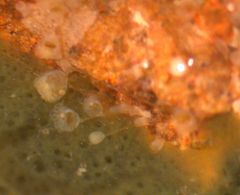Entoprocta
| Entoprocts | ||||||||
|---|---|---|---|---|---|---|---|---|
 Barentsia discreta
| ||||||||
| Scientific classification | ||||||||
| ||||||||
|
Barentsiidae (Urnatellidae) |
Entoprocta is a phylum of small, aquatic, largely marine, filter-feeding invertebrates that are characterized by having ciliated tentacles with a downstream-collecting ciliary system and without coelomic canals, and that have their anus inside the ring of tentacles. They range in size from only about 0.5 millimeters to 5.0 millimeters (0.02-0.2 inches). They are known as entoprocts, goblet worms, and kamptozoans.
The phylum includes about 150 species in four families. While most species are marine, there is one freshwater genus,
and the freshwater species Urnatella gracilis is widespread.
Overview and description
Entoprocts were originally grouped together with the ectoprocts in the phylum Bryozoa. Both are tiny, aquatic, sessile, filter feeding organisms, and are characterized by a tentacle crown with the ciliated tentacles used in filter feeding. This tentacle crown—which is known as a lophophore in the case of the ectoprocts (and in members of Phoronida and Brachiopoda)— is essentially a ciliated ribbon or string, which is either a horseshoe-shaped or a circular extension that surrounds the mouth (Smithsonian 2007; Luria et al. 1981). However, despite these similarities, it has come to be realized that the entoprocts and ectoprocts are very distinct and unrelated phyla (Thorp and Covich 2001).
One notable distinction between members of Endoprocta and those of Ectoprocta is that the ectoprocts have their anus outside their ring of tentacles, whereas the endoprocts have their anus inside the space enclosed by their tentacles (Ramel 2008). (Indeed, the ecotoprocts are placed together with the phoronids and brachiopods because of the lophophore, which may be defined as a crown of ciliated mesosomal tentacles surrounding the mouth but not the anus. (Thorp and Covich 2001).) The name Entoprocta comes from the Greek εντος, entos, meaning "inside," and προκτος, proktos, meaning "anus."
Another distinction between the ecotprocts and endoprocts is that the lophophore of ectoprocts has an upstream-collecting ciliary band, whereas the endoprocts have an downstream-collecting ciliar system like trochophore larve and adult rotifers (Nielsen 2002). Furthermore, the Ectoprocta are coelomate (possessing a body cavity) and their embryos undergo radial cleavage, while the Entoprocta are acoelemate and undergo spiral cleavage. Molecular studies are ambiguous about the exact position of the Entoprocta, but do not support a close relationship with the Ectoprocta. For these reasons, the Entoprocta are now considered a phylum of their own (Valentine 2004).
Entoprocts are filter feeders, their tentacles secreting a mucus that catches food particles, which is then moved towards the mouth by cilia on the tentacles. Nearly all species are sedentary, attached to the substrate by a stalk, with the body being cup-shaped. Some species are colonial, with multiple animals on branching systems of stalks.
Entoprocts can reproduce either by budding, or sexually. They are unusual in being sequential hermaphrodites.
Classification
Family Barentsiidae
- Genus Barentsia
- Genus Pedicellinopsis
- Genus Pseudopedicellina
- Genus Coriella
- Genus Urnatella
Family Loxokalypodidae
- Genus Loxokalypus
Family Loxosomatidae
- Genus Loxosoma
- Genus Loxosomella
- Genus Loxomitra
- Genus Loxosomespilon
- Genus Loxocore
Family Pedicellinidae
- Genus Pedicellina
- Genus Myosoma
- Genus Chitaspis
- Genus Loxosomatoides
ReferencesISBN links support NWE through referral fees
http://icb.oxfordjournals.org/cgi/content/full/42/3/685 Integrative and Comparative Biology 2002 42(3):685-691; doi:10.1093/icb/42.3.685 © 2002 by The Society for Integrative and Comparative Biology The Phylogenetic Position of Entoprocta, Ectoprocta, Phoronida, and Brachiopoda1 Claus Nielsen2
- Luria, S. E., S. J. Gould, and S. Singer. 1981. A View of Life. Menlo Park, CA: Benjamin/Cummings Publishing Company. ISBN 0805366482
- Ramel, G. 2005. The Phylum Ectoprocta (Bryozoa). Earth Life Web. Retrieved December 17, 2007.
- What is a bryozoan. Smithsonian Marine Station at Fort Pierce, 2007. Retrieved February 13, 2007.
- Waggoner, B., and A. G. Collins. 1999. Bryozoa: Life history and ecology. University of California Museum of Paleontology. Retrieved February 13, 2007.
Ecology and Classification of North American Freshwater Invertebrates By James H. Thorp, Alan P. Covich Contributor James H. Thorp Published by Academic Press, 2001 ISBN 0126906475, 9780126906479 1056 pages
Credits
New World Encyclopedia writers and editors rewrote and completed the Wikipedia article in accordance with New World Encyclopedia standards. This article abides by terms of the Creative Commons CC-by-sa 3.0 License (CC-by-sa), which may be used and disseminated with proper attribution. Credit is due under the terms of this license that can reference both the New World Encyclopedia contributors and the selfless volunteer contributors of the Wikimedia Foundation. To cite this article click here for a list of acceptable citing formats.The history of earlier contributions by wikipedians is accessible to researchers here:
The history of this article since it was imported to New World Encyclopedia:
Note: Some restrictions may apply to use of individual images which are separately licensed.